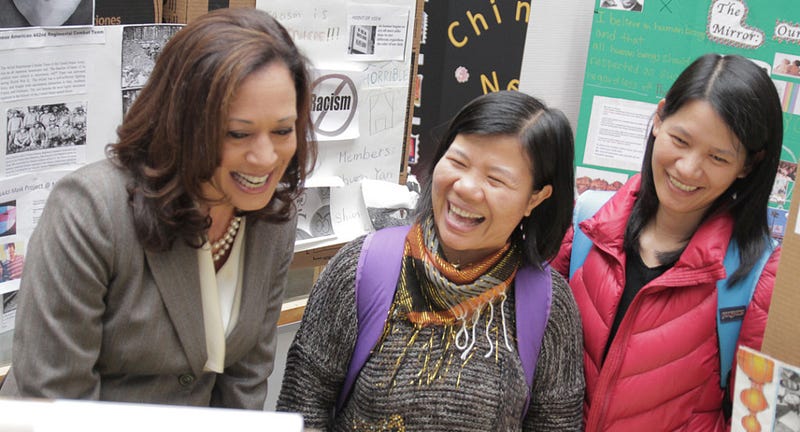
California Atty. Gen. Kamala Harris paid a visit to the Laney campus Oct.11, honoring the student creators of the “What Mask Are You Wearing” art exhibit located in the library.
Amongst a gaggle of talkative students and staff, Harris perused the colorful projects that students of the Asian/Asian-American Studies program have displayed in the library since September.
“I think it’s great because we normally wouldn’t get the opportunity to speak with someone of the higher judicial system,” said Chun Cheung, one of over 260 students who have contributed to the exhibition.
Harris was showered with gifts by faculty members and students who introduced her at the podium. These included flowers, a t-shirt, and a Laney tote bag and Laney Logo shot glass.
“Every time I see you, I feel like I’m looking at an old spirit,” said Laney President Elñora Webb, introducing Harris. “I know I’m looking at a sister.”
To begin her speech, Harris expressed her gratitude to the Laney students who contributed to the exhibit.
“You are all doing an extraordinary job of understanding that we must never forget our history — ever,” Harris said.
Harris, who was born in Oakland, spoke about her parents, both former students at U.C. Berkeley, who were heavily involved in the Civil Rights Movement and were subjected to harrowing experiences during that time.
Lawyers, Harris said, were the architects of the Civil Rights Movement, and she listed them as among the heroes of that period.
“I couldn’t help but be impacted by that movement, and that struggle, and that fight, and that commitment to equality and justice…In fact, that’s why I decided to become a lawyer,” she said.
Quoting Coretta Scott King, Harris pointed out that the struggle for equality must be renewed with each generation, and that it was the obligation of students today to carry on that fight.
“Your generation carries the responsibility to do exactly what [King] said,” Harris said.
After conducting a study on California schools, Harris found that children who cannot read at a third grade level by the time they reach that grade are unable to recover their education, and often drop out of school later on.
Eliminating elementary school truancy, Harris said, was key to cutting back on crime in the state.

Concluding her speech, Harris laid down some of her wisdom for students to consider.
“There may seem to be differences between us, but when it comes down to it, we have everything in common when we talk about our need to fight for equality, for freedom,” she said.
The attorney general has deep roots in the Bay Area. Harris was born in Oakland and attended summer classes at Laney.
Harris’ godmother, Dr. Mary Agnes Lewis, was a professor at Laney and co-founded the Black Studies Department at San Francisco State University. Lewis was a close friend of Harris’ mother, and Harris called her “Aunt Mary.”
After her speech, the floor was opened for students to ask Harris questions. As a response to most of the questions, Harris used examples of her career.
Her negotiations, on the behalf of foreclosure victims, with the five largest banks in the country and her investigation of human trafficking on the California-Mexico border were two issues that Harris talked about at length.
A student asked Harris what were her future goals. Harris laughed, “Who planted you in here?” she asked jokingly.
Harris said that she is enjoying what she is doing now, and that she will run for reelection next year.
One of the focuses of her future career, said Harris, would be on elementary school truancy.
When asked what advice she had for students balancing work, school, and a social life, Harris answered, “You gotta get it done…Just keep doing what you’re doing and know that it’s going to pay off. I promise you that.”
Asian/Asian-American studies professor Janine Fujioka organized both the exhibit and Harris’ visit. Fujioka was ecstatic over Harris’ visit.
“The Honorable Kamala Harris’ speech was informative, inspirational and thought provoking,” Fujioka said, “I believe she is giving back.”
The “What Mask Are You Wearing?” exhibit closed Oct 23 after more than a month on display.

























